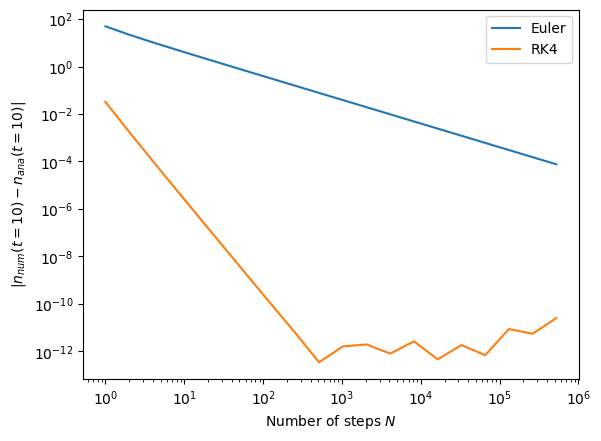Assignment 3
General Feedback
The assignment was solved well in general but here are some common problems that occurred.
-
many people used a linear scale to generate the data for the error plot. If you are going to plot on a log scale it is more efficient to use points equidistant on a log scale. Some people did not make a log-log plot.
-
some did not realise that one needs to use a fixed time interval to evolve the ODE over (for example from t=0 to t=1000) and therefore one has to change the size of
dtlikedt = (t1 - t0) / n_stepsto adapt to changing the number of steps. The time used for the analytical reference value should also match! -
one elegant way of accessing the last element in an array or list
ais to use-1as the index.
a = [ 1, 2, 3, 4, 5, 6, 7, 8]
last_element = a[-1]
-
always use the functions you had written, and importantly tested, at the start. Don’t copy the code further down the notebook. At best this is inefficient, at worst if can lead to mistakes.
-
Some students were still missing labels, title or a legend, or labelling axes as log when a log scale had been used (you should only put log in the label if you have taken and plotted the logs)
-
Some students had issues in the code, such as undefined variables. Make sure you run validate or ‘restart and run all’ to check for this
Model solution
Automatically marked cells:
# define a function to calculate the mean lifetime from the half life
def meanLifetime(halfLife):
mean = halfLife/ numpy.log(2)
return mean
T_HALF = 20.8
TAU = meanLifetime(T_HALF)
def f_rad(N, t):
return - N / TAU
def analytic(N0, t):
return N0 * numpy.exp(-t/TAU)
def solve_euler(f, n0, t0, dt, n_panels):
# Initialise variables
n = n0
t = t0
n_t = numpy.empty((n_panels+1)) # Array ready for updated counts
# For loop generating decay data in n_panels steps of width dt using Euler's method
for i in range(n_panels+1):
n_t[i] = n
n += dt*f(n, t)
t += i*dt # For completeness, but this ODE does not need time.
return n_t
def solve_RK4(f, n0, t0, dt, nsteps):
res_n = numpy.array([0.0] * ( nsteps + 1 ))
current_n = n0
current_t = t0
res_n[0] = current_n
for i in range(1,nsteps+1):
k1 = f(current_n , current_t)
n1 = current_n + k1* dt/2.0
k2 = f(n1, current_t + dt/2.0)
n2 = current_n + k2* dt/2.0
k3 = f(n2, current_t + dt/2.0)
n3 = current_n + k3* dt
k4 = f(n3, current_t + dt )
k = 1.0/6.0 * ( k1 + 2 * k2 + 2 * k3 + k4 )
current_n += dt * k
current_t += dt
res_n[i] = current_n
return res_n
Plotting task
This is an example for the plotting task.
n0 = 1000
target = analytic(n0, 10.0 )
err_euler = []
err_rk4 = []
ntest = [ 2**expo for expo in range(20) ]
for n_step in ntest:
res_euler = solve_euler(f_rad,n0, 0, 10.0/n_step, n_step)
res_rk4 = solve_RK4(f_rad,n0, 0, 10.0/n_step, n_step)
err_euler.append( abs( res_euler[-1] - target) )
err_rk4.append( abs( res_rk4[-1] - target) )
plt.plot(ntest, err_euler, label='Euler')
plt.plot(ntest, err_rk4, label='RK4')
plt.loglog()
plt.legend()
plt.xlabel('Number of steps $N$')
plt.ylabel('$|n_{num}(t=10)-n_{ana}(t=10)|$');

Using scipy
Again if we really had to solve this problem we would use scipy. The solve_ivp function provides access to a range of
different methods. The default is called RK54 which uses the 5th order Runge-Kutta method to compute the values together with the 4th order to
estimate the error. It needs the function for the derivative to have both the value and the time, this is why ours had this, although in the opposite
order.
import scipy.integrate as integrate
def f(t,n) :
return f_rad(n,t)
output = integrate.solve_ivp(f,(0,tmax),numpy.array([n0]),rtol=1e-9)
print((output.y[0][-1]-target)/target)
1.3500933701583496e-10